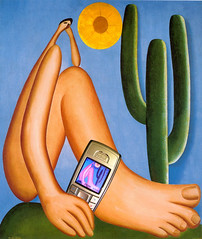François Bar has just sent me a link to the Abaporu blog, part of a research project he is doing with Francis Pisani and Matt Weber on the appropriation of new technologies, more specifically mobile technology.
Abaporu (aba = man; poru = to eat, in tupi-guarani) is also the name of the 1928 painting Tarsila do Amaral made for her husband, poet Oswald de Andrade. The composition – a man, the sun and a cactus inspired him to write the Cannibal Manifesto and create the Cannibal Movement as a reaction to European post-colonial cultural domination.
Along the same lines, the blog documents how people make the technology their own and embed it within their social, economic, and political practices. In the draft paper , the authors locate appropriation practices within a 3-step technology cycle (adoption / appropriation / re-configuration). One very interesting post shows that an important way in which people appropriate technology is by naming what they do with it – a whole new vocabulary which expresses their relationship with it.
I had an interesting discussion in class with my students about it but apparently most are either very conventional users or they did not want to disclose their secrets as to the usage of mobiles at school! (one did disclose though that exchanging homework files and information about tests from one class to another through SMS is a common practice). We have recently had students filming, photographing and recording teachers in their classrooms without their consent or knowledge, which brings up an ethical problem.
As far as language goes, the most common expressions seem to be the conventional ones. The most colourful ones are “deu pau” (when the telephone fails to work) or “me dá um toque” (literally touch me or give me a ring – keep in touch). Torpedo for the SMS messages has been invented by some phone companies. I do not see how they fit as torpedoes are not part of our culture but belong to the warfare lexical field.
François was in São Paulo earlier this year looking for E-governance projects in this area and talking to people involved in mobile technology and projects. Through the Abaporu blog I found the Motoboy Channel, a fascinating perspective of what happens on the streets of the city I live in and which I was totally unaware of.
I must say that digital culture does open us to cultural and social diversity. Without these new technologies, I would have never had access or met any of the people I am presently in contact with and would have never learnt so much. Besides, by being immersed in our own culture, we take most of our everyday actions for granted so it is very difficult to describe them.
It is through the interaction and “friction” with outside perspectives, or when we distance ourselves from our culture and ourselves that we are able to notice certain aspects more clearly, rediscover our traditions and establish a different relationship with the Other.
Culture, as I see it, is not a fixed product to be exhibited in a museum but a vast field encompassing a lively and complex interaction and intersection paths occurring between human beings and the world they inhabit, the symbols they use to convey meaning, the inumerous spaces they transit in and leave their footprints and the knowledge that emerges from it.

Thanks Bee! Our students don’t use SMS in class very much, probably because texting (as we call it here) isn’t that widespread yet in the US. But that’s changing, in part because of twitter…
Abraços,
F.